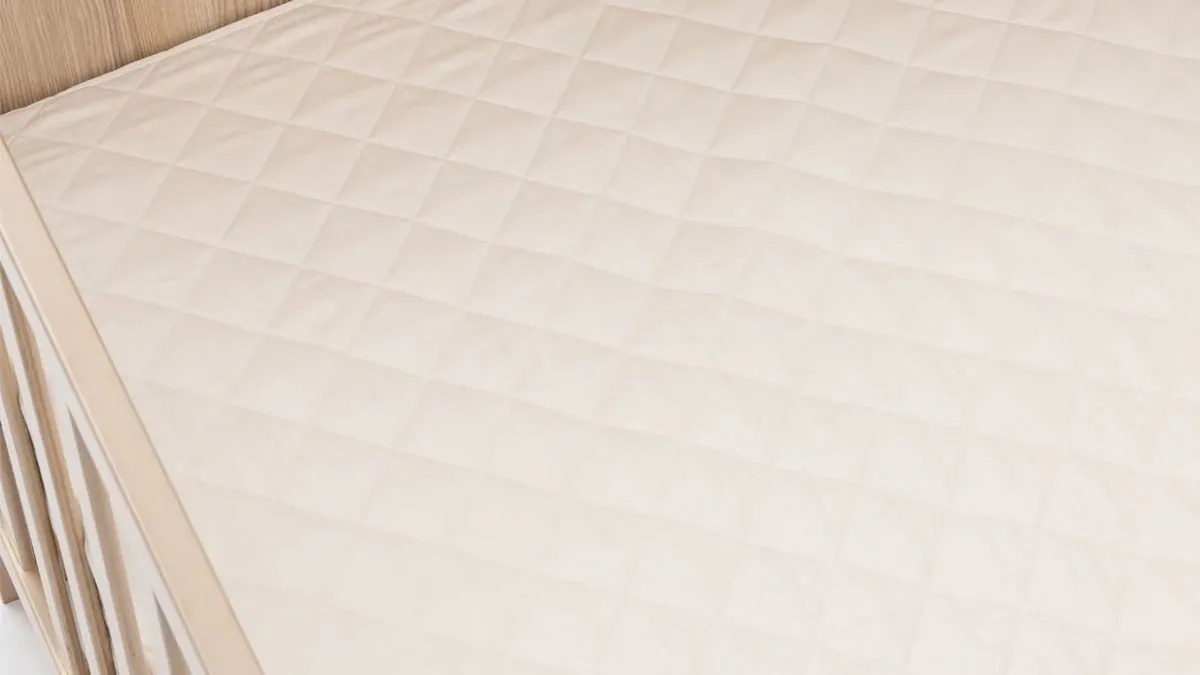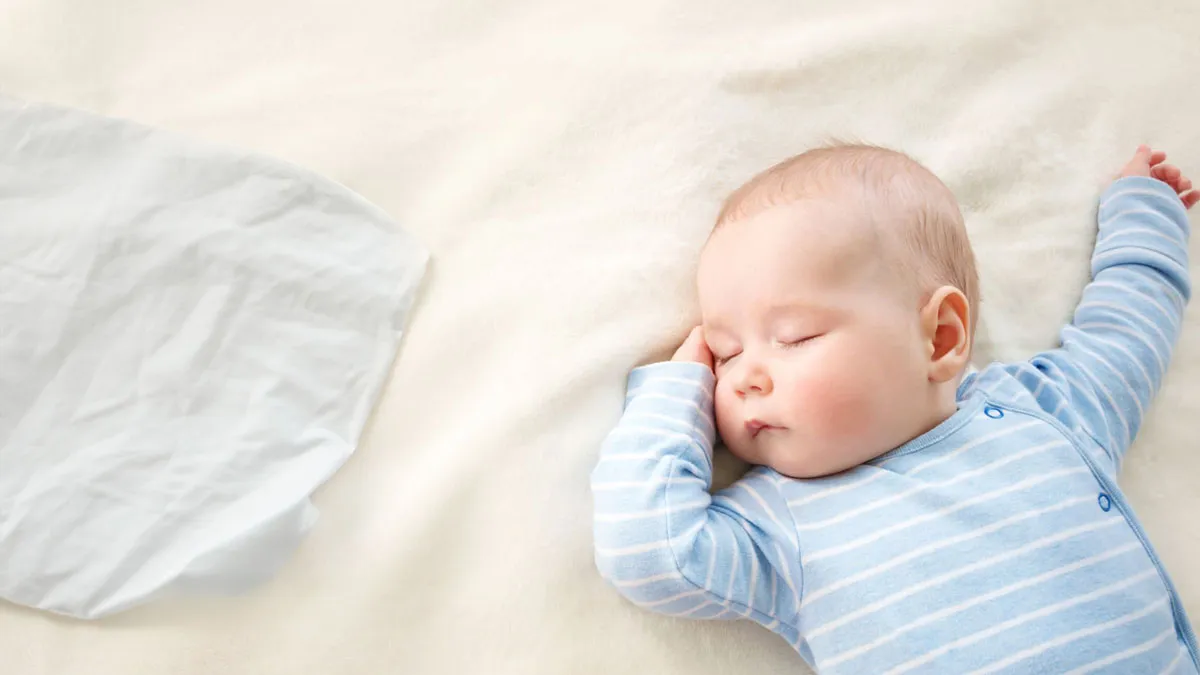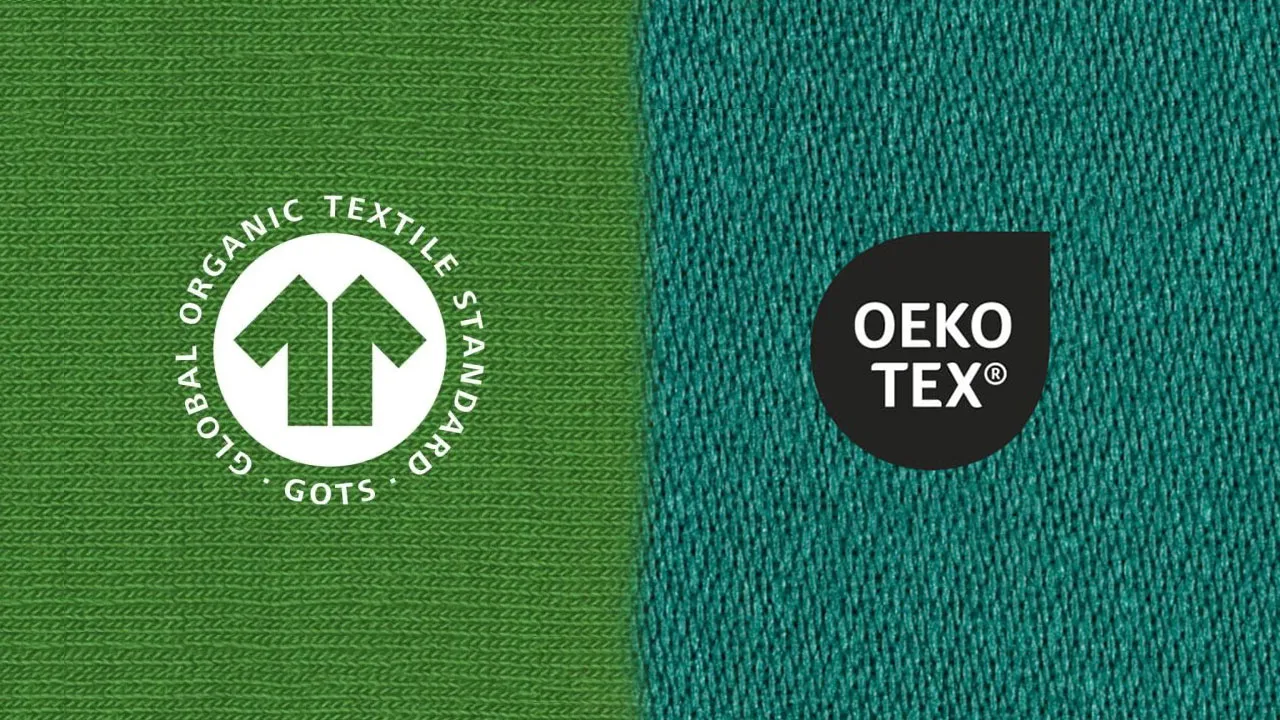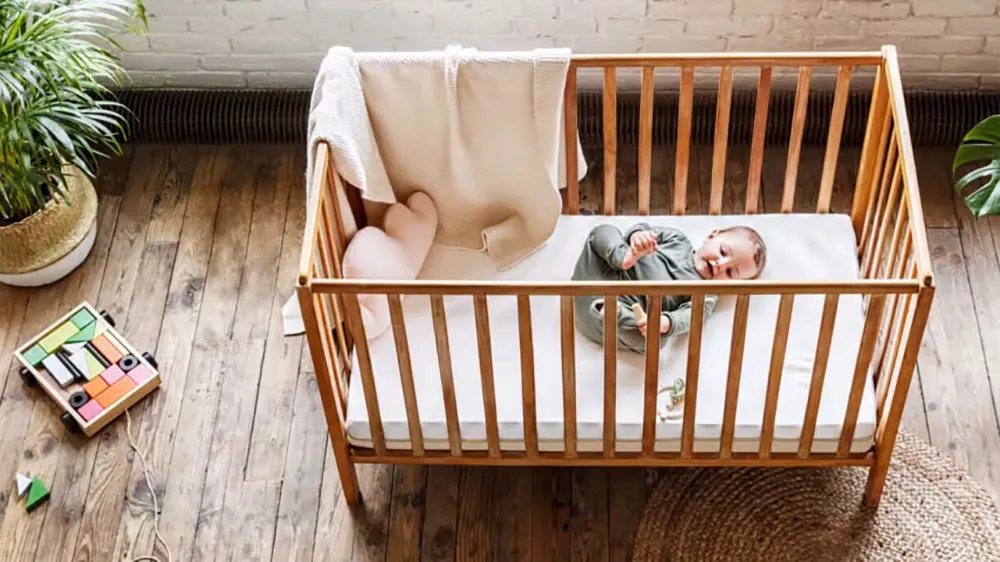How to Choose a Baby Cot Mattress Protector
Let's chat about something just as crucial as your baby's mattress - the protector that goes on top of it. Even if your cot mattress has a zip-off cover, here's a truth most parents learn the hard way: you absolutely need a waterproof cot mattress protector. Why? Because those inevitable accidents (wee, spewing, and sweating) will seep right through into your mattress, creating a perfect breeding ground for mould and bacteria. And trust me - once that happens, no amount of white vinegar, natural soap, or elbow grease will fully restore your mattress.
Your baby mattress protector is the protective layer your infant sleeps on after the fine layer of sheets, making it just as important as the mattress itself. That's why we always recommend having three protectors in rotation—one on the cot, one in the wash, and one ready to go (but having two is also okay). Since it's in close contact with your newborn's skin, choosing natural materials like bamboo or organic cotton isn't just a nice-to-have; it's essential.
Top 5 baby cot mattress protectors
Our ratings and recommendations are neutral, focusing only on design quality, price value, and materials to find the best cot mattress protector for your baby. Read the article to learn more about why we recommend these products.
The Natural Bedding Company
Editor’s Choice100% Organic Cotton Cot Mattress Protector
Premium GOTS-certified organic cotton with elegant diamond stitching for exceptional softness and superior moisture management. Fair Trade produced (200 GSM) with fitted organic cotton skirt ensuring perfect placement. The ultimate chemical-free protection for your precious baby's delicate skin and peaceful, healthy sleep.
- Cover:100% Organic Cotton
- Waterproof:No waterproofing
- Wadding:100% Organic Cotton
- Certification:GOTS
Sacred Bundle
100% Pure Organic Cotton Cot Protector
Pure organic cotton breathable protection perfectly fitting standard cots. Allows optimal airflow while providing gentle defense against accidents. Sustainably sourced, toxin-free, and machine washable—combining cloud-like softness, exceptional durability, and effortless care for your little one's comfort.
- Cover:100% Organic Cotton
- Waterproof:No waterproofing
- Wadding:100% Organic Cotton
- Certification:GOTS
Kiin Baby
Organic Fitted Cot Mattress Protector
Luxury organic cotton cover with quilted absorption layer and waterproof PU backing. Thoughtfully designed hypoallergenic construction prevents leaks while maintaining comfort. Free from harmful chemicals, offering reliable everyday protection against spills, accidents, and allergens for worry-free nights.
- Cover:100% Organic Cotton
- Waterproof:PU
- Wadding:100% Cotton
- Certification:Not specified
Sleep Corp
TENCEL Fitted Cot Protector
Advanced TENCEL™ technology with breathable, hypoallergenic waterproofing for ultimate protection. Effectively guards against spills, dust mites, mold, and bacteria. Expandall® fitted skirt accommodates both standard and extra-deep cots. Machine washable for convenient, hassle-free maintenance.
- Cover:100% Tencel (Wood)
- Waterproof:TPU (Miracle Layer)
- Wadding:Not padded
- Certification:Asthma Council
Bubba Blue
Bamboo Cot Mattress Protector
Ultra-soft bamboo top layer with secure TPU waterproof backing for natural protection. Lightweight, quick-drying, and fully fitted to standard cots. Easily machine washable for effortless maintenance—keeping your baby's sleep space clean, comfortable all night long.
- Cover:Bambou
- Waterproof:TPU
- Wadding:Bambou
- Certification:Not specified
How to choose the perfect cot mattress protector
Feeling overwhelmed by the endless options at the bub shop? From $15 cot protectors at Kmart to $50+ "premium" versions, it's a maze of marketing promises. But here's what those cheap prices don't tell you: during those hours of daily sleep, your newborn's delicate skin absorbs everything from its environment.
While your baby's immune and respiratory systems are still developing, those inexpensive IKEA polyester protectors expose your little one to synthetic chemicals at their most vulnerable stage. That's why choosing the right cot mattress protector matters more than you think.
Here are just four essential things your baby's protector needs to have:
- Toxin-Free: Your protector should be free from chemical treatments, VOCs, and endocrine disruptors that can interfere with your baby's developing systems.
- Breathable: Your cot protector must allow airflow and moisture to escape, preventing heat retention and the sweaty, clammy environment that synthetic materials create.
- Hypoallergenic: With rising allergies, it is crucial to choose materials that naturally resist dust mites and bacteria (without chemical treatments).
You might wonder why we don't insist on waterproofing—jump to our waterproof section to understand the marketing claims and truth behind this feature. In any case, during your baby's early stages, you'll change the protector every 2-3 days anyway, so a thick cotton or wool protector will generally do the job just fine.
Here's the good news: for just $50, you can get an infant mattress protector made from natural materials like organic cotton, bamboo or merino wool, which combine all these benefits naturally. Even conventional cotton, when processed without harmful chemicals, works brilliantly. Nature has already perfected these materials—they're breathable, naturally antimicrobial, and gentle on sensitive skin.

The best & worst materials for a cot mattress protector
Skip the marketing jargon—when product descriptions don't clearly specify materials, it usually means there's polyester hiding behind those fancy "waterproof-wicking technology" claims! Nature has already sorted this out with materials that don't need chemical treatments or fancy tech names to work brilliantly.
What to Look For
- Organic Cotton: the gold standard – breathable, natural, and gentle on sensitive skin.
- Bamboo Fiber: naturally antimicrobial and wonderfully soft.
- Tencel: sustainable, incredibly soft, and excellent at moisture management.
- Natural Wool: excellent for temperature regulation (though pricier).
What to Avoid
- Polyester: these fabric traps lack breathability and can contain chemicals that may irritate your baby's sensitive skin.
- PVC backing: despite claims of being "medical grade," PVC contains phthalates and other chemicals that can off-gas harmful VOCs directly under your baby's sleeping area.
If you find yourself in a position where only synthetic options are available, choose certified polyester over polyurethane (PU). While neither is ideal, certified polyester tends to be safer, especially those with certifications that guarantee they don't contain harmful substances for your baby. But remember, this should be your last resort, not your first choice, as all synthetics contain some endocrine disruptors and release volatile organic compounds (VOCs - harmful chemicals that off-gas into the air).
A quick note about bed sheets for infants
The same principles apply to your baby's cot sheets - avoid synthetic fabrics like polyester or mysterious blends. When it comes to sheets, you have three excellent natural options:
- Washed Linen: superior breathability and temperature regulation, incredibly durable, standing up to frequent washing. While it's typically the most expensive option, its durability makes it a long-term investment.
- Bamboo: is ultra-soft and silky, with a luxurious feel. It also provides excellent temperature regulation and has natural antibacterial and hypoallergenic properties.
- Cotton: ultra-soft and breathable, perfect for baby's sensitive skin, naturally hypoallergenic for peaceful sleep.
Your baby's sheets are the first layer touching their skin, so choosing the right material is just as crucial as selecting the proper mattress protector.
But aren't antibacterial treatments safer for my baby?
We hear this a lot. The irony is that these treatments add unnecessary chemicals to your newborn's sleep environment. Natural materials like bamboo, cotton, and wool are already naturally antibacterial - they've been doing this for thousands of years without any help from chemical labs!
Waterproof cot mattress protectors: essential or optional?
Not all waterproof claims are equal—some barely handle a slight drool, while others can contain an entire bottle spill. Among natural materials, wool takes the crown for water resistance (those sheep know what they're doing!), followed closely by densely woven bamboo and organic cotton with proper waterproof backing.
At True Dream, we understand babies are messy, but we prioritise protectors without waterproof layers, instead opting for thicker wadding of 200gm+, which does the job effectively. However, if your baby is particularly messy, consider a protector with safe TPU waterproofing
While a waterproof layer does prevent liquids from seeping into the mattress, where mould and mildew can grow, we believe in finding the right balance between protection and using natural materials against your baby's skin.
Here are the main types of waterproofing protector to consider:
- Natural Membrane: the gold standard - uses multiple layers of tightly woven natural fibres that, while not completely waterproof, are sufficient to contain liquid spills and protect the mattress underneath.
- TPU (Thermoplastic Polyurethane): This is your best synthetic material for waterproof protection. It's more eco-friendly than PVC and doesn't off-gas nasty chemicals. Look for ones backed with natural fibres.
- PVC Layer: The cheapest option. Avoid these - they're plastic sheets that don't breathe and can release harmful chemicals.
Want to test whether your baby protector is genuinely waterproof? Pour a small amount of water on it and wait 20 minutes. A good protector will keep the water beaded on top without any seepage. Just remember—even the best waterproofing should still let your mattress breathe!

PVC, PU... wait, what?
Let's be honest - if you need a chemistry degree to understand cot mattress protector materials, you're not alone! This is precisely why we recommend going natural (no PhD required).
Sure, these synthetic combinations can achieve waterproofing in various ways, but at what cost? Our only exception is for certified TPU (Thermoplastic Polyurethane), which meets strict safety standards.
For everything else, you might as well wrap your cot in a plastic tarp - it would be waterproof, too, but would you really want your infant sleeping on that?
How to keep your baby cool in Australia
Breathability in cot mattress protectors is crucial for your baby's comfort and safety. While many waterproof protectors claim to be breathable, the truth lies in their materials. Natural fibres like organic cotton, bamboo, Tencel, and wool provide superior breathability compared to synthetic alternatives.
Why is a breathable cot protector so important?
- Prevents moisture buildup that can lead to mould and bacteria.
- Reduces sweating and overheating during sleep.
- Maintains proper airflow through your baby's mattress.
- Regulates temperature during hot Australian summers and mild winters.
The best breathable protectors vary depending on your location in Australia and your bub needs. Bamboomboo is excellent for superior airflow and moisture control in humid Queensland and Northern Territorytrol.
In Victoria and Tasmania's cooler climates, wool and cotton offer natural temperature regulation that's hard to beat. For hot, dry areas like Western Australia and South Australia, organic cotton or bamboo provides perfect natural ventilation.
Tencel works well anywhere, especially for babies with sensitive skin or eczema. While not very common in cot protectors (it's more typically found in sheets), some brands offer combination protector sheets made with Tencel for its benefits.
There's no universal rule - all these materials cost about the same and have kept babies comfortable for generations. Just choose what suits your climate and your little one's needs best. No fancy synthetic technology is required!
Do certifications really matter for a baby mattress protector?
Here are the certifications that mean something for your baby's mattress protector. If you spot these on the label, you know you're getting the real deal:
- GOTS (Global Organic Textile Standard): The gold standard for organic materials. It ensures your protector is made from organic fibres and processed without harmful chemicals.
- OEKO-TEX® Standard 100: Guarantees every component, from threads to elastics, has been tested for harmful substances. If you see this, you can rest easy knowing your protector is free from nasty chemicals.

Why do some natural baby products skip certification?
Don't panic if you can't find these certifications on your mattress protector - their absence doesn't automatically mean the product is unsafe. Most review websites won't tell you that certifications cost money, lots of it. For mattress protector manufacturers who offer multiple sizes and styles, certifying each variation can become extremely expensive. That's why some brands, especially smaller ones, might skip certifications while still using top-quality natural materials.
Hypoallergenic - What it means
Big brands don't want you to know an industry secret: proper hypoallergenic and antibacterial protection doesn't need fancy chemical treatments or special coatings. Natural materials like organic cotton, bamboo, and wool have been doing this perfectly for thousands of years.
They naturally resist dust mites, bacteria, and other allergens simply because nature designed them to do that. So when you see expensive treatments promising "enhanced" protection, remember: nature already perfected these materials long before laboratories got involved.
The perfect fit - because gaps are not your friend
The perfect fit isn't just about looks—it's about your baby's safety. Even the most expensive protector becomes a hazard if it doesn't fit properly. Think of your mattress protector as your bub's second skin—it must hug every corner of the mattress perfectly, without any bunching, gaps, or loose edges that could compromise safety or comfort.
Key fitting points:
- Corners should be snug but not straining.
- No wrinkles or bunching in the middle.
- Elastic should grip firmly under the mattress.
- Zero gaps between protector and mattress edges.
Remember, according to Red Nose Australia's safety guidelines, the gap between your mattress and cot frame should never exceed 20 mm.

Cleaning your cot mattress protector - Yes, it matters!
Here's something that might seem obvious but is worth repeating: what's the point of choosing a natural, chemical-free protector if you're going to wash it with harsh detergents? Keep it simple:
- Use gentle, natural detergents.
- Wash at 40°C (hot enough to kill germs, cool enough to protect).
- Skip fabric softeners (they can affect the waterproofing).
- Line dry when possible (sunshine is nature’s best disinfectant).
We recommend rotating three protectors: one on the cot, one getting washed, and one on standby. Trust us, those middle-of-the-night accidents are much easier to handle when you've got a clean protector ready!
But let's be honest - if you go two weeks without needing to clean your baby’s mattress protector due to accidents, you deserve a parenting medal! (Particularly during your baby’s first year.)
But here's what really matters:
- Ideally, every 2 weeks (but we know how life goes with a baby!).
- Immediately after any accidents (wee, spills, sickness).
- When you notice any odd smells.
- If you see visible stains.
In conclusion, every layer matters
Creating the perfect sleep sanctuary for your little one isn't just about following trends—it's about making informed choices that directly impact their comfort, health, and development.
During those critical early years, your baby will spend up to 16+ hours daily on its cot mattress. By choosing the right materials with thoughtful protection, you're not just buying bedding—you're investing in quality sleep
And the good news? This investment doesn't need to break the bank. With around $150, three high-quality, completely organic protectors should easily last through your infant's entire cot journey—at worst, you might need to replace one during the second year if accidents are frequent.
Remember These Key Takeaways:
- Prioritise natural fabrics that allow your baby's skin to breathe
- Rotate at least 2-3 protectors for practicality during those messy early days
- Certified TPU if you need a waterproof layer
- Invest in quality now to avoid frequent replacements and potentially harmful materials
But they're just one piece of your baby's sleep puzzle. Just like you need the right cot protector, your baby also needs the perfect cot mattress and breathable sheets to complete their sleep sanctuary. Every layer matters in creating a safe, comfortable haven for your precious little one.
Sweet dreams to your bub and peace of mind for you!

